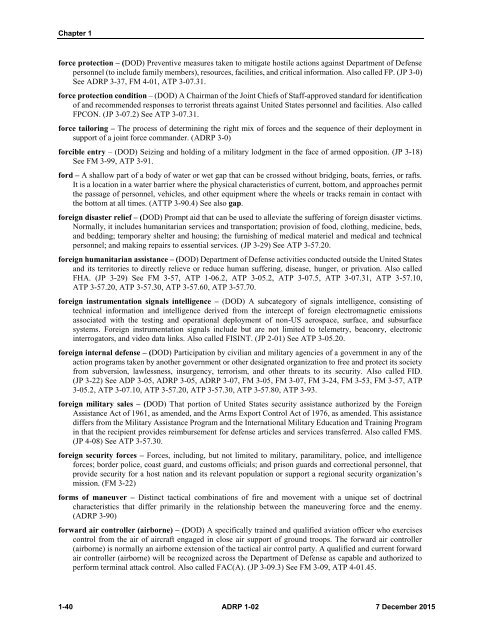ADRP1-02
52543f77c16bcfa46f6e1de2B038ef195
52543f77c16bcfa46f6e1de2B038ef195
You also want an ePaper? Increase the reach of your titles
YUMPU automatically turns print PDFs into web optimized ePapers that Google loves.
Chapter 1<br />
force protection – (DOD) Preventive measures taken to mitigate hostile actions against Department of Defense<br />
personnel (to include family members), resources, facilities, and critical information. Also called FP. (JP 3-0)<br />
See ADRP 3-37, FM 4-01, ATP 3-07.31.<br />
force protection condition – (DOD) A Chairman of the Joint Chiefs of Staff-approved standard for identification<br />
of and recommended responses to terrorist threats against United States personnel and facilities. Also called<br />
FPCON. (JP 3-07.2) See ATP 3-07.31.<br />
force tailoring – The process of determining the right mix of forces and the sequence of their deployment in<br />
support of a joint force commander. (ADRP 3-0)<br />
forcible entry – (DOD) Seizing and holding of a military lodgment in the face of armed opposition. (JP 3-18)<br />
See FM 3-99, ATP 3-91.<br />
ford – A shallow part of a body of water or wet gap that can be crossed without bridging, boats, ferries, or rafts.<br />
It is a location in a water barrier where the physical characteristics of current, bottom, and approaches permit<br />
the passage of personnel, vehicles, and other equipment where the wheels or tracks remain in contact with<br />
the bottom at all times. (ATTP 3-90.4) See also gap.<br />
foreign disaster relief – (DOD) Prompt aid that can be used to alleviate the suffering of foreign disaster victims.<br />
Normally, it includes humanitarian services and transportation; provision of food, clothing, medicine, beds,<br />
and bedding; temporary shelter and housing; the furnishing of medical materiel and medical and technical<br />
personnel; and making repairs to essential services. (JP 3-29) See ATP 3-57.20.<br />
foreign humanitarian assistance – (DOD) Department of Defense activities conducted outside the United States<br />
and its territories to directly relieve or reduce human suffering, disease, hunger, or privation. Also called<br />
FHA. (JP 3-29) See FM 3-57, ATP 1-06.2, ATP 3-05.2, ATP 3-07.5, ATP 3-07.31, ATP 3-57.10,<br />
ATP 3-57.20, ATP 3-57.30, ATP 3-57.60, ATP 3-57.70.<br />
foreign instrumentation signals intelligence – (DOD) A subcategory of signals intelligence, consisting of<br />
technical information and intelligence derived from the intercept of foreign electromagnetic emissions<br />
associated with the testing and operational deployment of non-US aerospace, surface, and subsurface<br />
systems. Foreign instrumentation signals include but are not limited to telemetry, beaconry, electronic<br />
interrogators, and video data links. Also called FISINT. (JP 2-01) See ATP 3-05.20.<br />
foreign internal defense – (DOD) Participation by civilian and military agencies of a government in any of the<br />
action programs taken by another government or other designated organization to free and protect its society<br />
from subversion, lawlessness, insurgency, terrorism, and other threats to its security. Also called FID.<br />
(JP 3-22) See ADP 3-05, ADRP 3-05, ADRP 3-07, FM 3-05, FM 3-07, FM 3-24, FM 3-53, FM 3-57, ATP<br />
3-05.2, ATP 3-07.10, ATP 3-57.20, ATP 3-57.30, ATP 3-57.80, ATP 3-93.<br />
foreign military sales – (DOD) That portion of United States security assistance authorized by the Foreign<br />
Assistance Act of 1961, as amended, and the Arms Export Control Act of 1976, as amended. This assistance<br />
differs from the Military Assistance Program and the International Military Education and Training Program<br />
in that the recipient provides reimbursement for defense articles and services transferred. Also called FMS.<br />
(JP 4-08) See ATP 3-57.30.<br />
foreign security forces – Forces, including, but not limited to military, paramilitary, police, and intelligence<br />
forces; border police, coast guard, and customs officials; and prison guards and correctional personnel, that<br />
provide security for a host nation and its relevant population or support a regional security organization’s<br />
mission. (FM 3-22)<br />
forms of maneuver – Distinct tactical combinations of fire and movement with a unique set of doctrinal<br />
characteristics that differ primarily in the relationship between the maneuvering force and the enemy.<br />
(ADRP 3-90)<br />
forward air controller (airborne) – (DOD) A specifically trained and qualified aviation officer who exercises<br />
control from the air of aircraft engaged in close air support of ground troops. The forward air controller<br />
(airborne) is normally an airborne extension of the tactical air control party. A qualified and current forward<br />
air controller (airborne) will be recognized across the Department of Defense as capable and authorized to<br />
perform terminal attack control. Also called FAC(A). (JP 3-09.3) See FM 3-09, ATP 4-01.45.<br />
1-40 ADRP 1-<strong>02</strong> 7 December 2015


